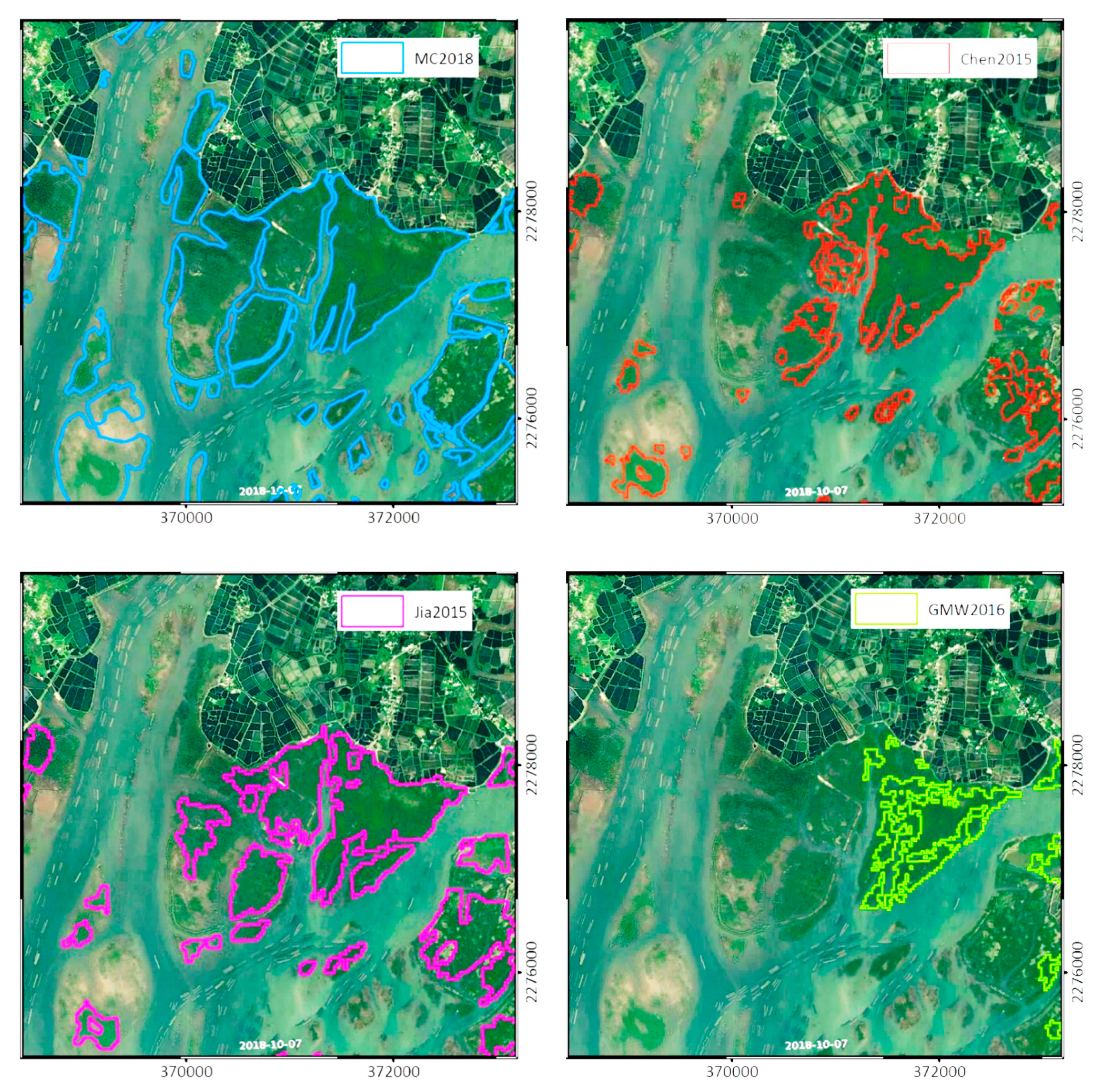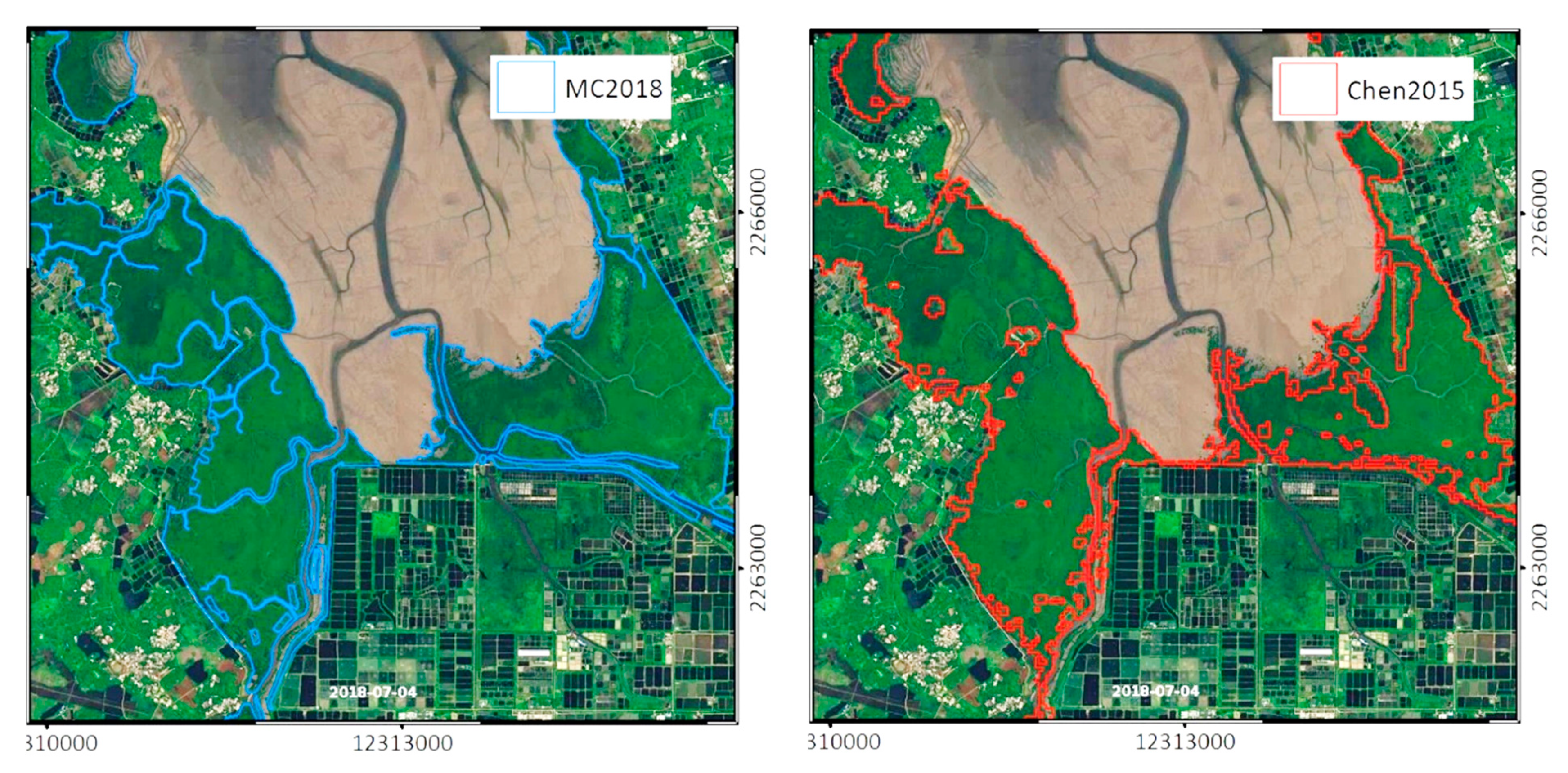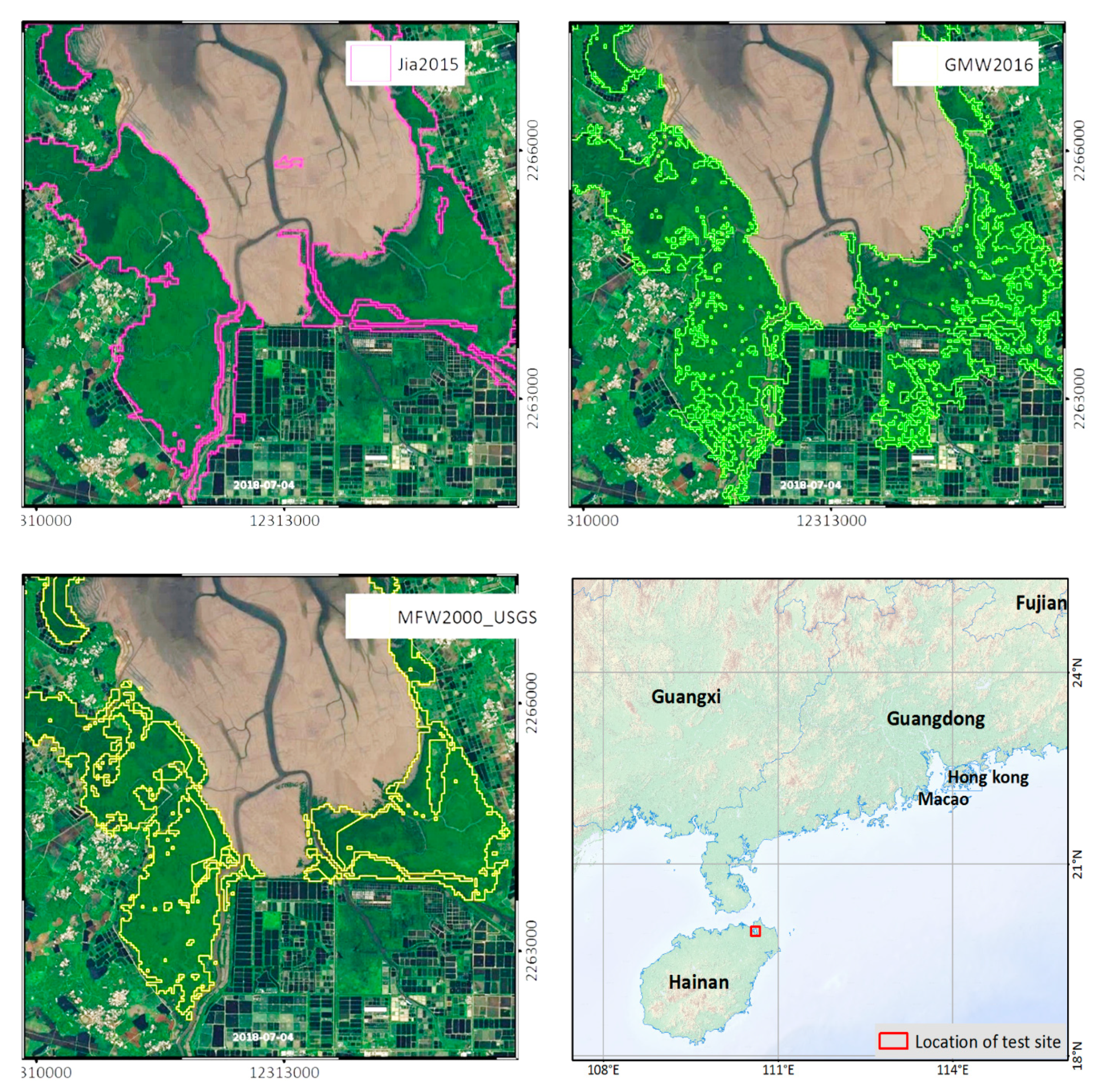A Fine-Scale Mangrove Map of China Derived from 2-Meter Resolution Satellite Observations and Field Data
Abstract
:1. Introduction
2. Materials and Methods
2.1. Study Area
2.2. Data and Processing
2.2.1. Satellite Remote Sensing Images and Processing
2.2.2. Mangrove Habitat Preparation
2.3. Methods for Mangrove Delineation
2.3.1. OBIA Procedure for Mangrove Delineation
2.3.2. Interpreter Checking
2.3.3. Field Verification
2.4. Accuracy Assessment
2.5. Inter-Comparison with Other Available Mangrove Forest Maps or Datasets
3. Results
3.1. Spatial and Area Distribution of Mangroves in China in 2018
3.1.1. Distribution of Mangroves in Different Provinces
3.1.2. Distribution of Mangroves in the Latitudinal and Longitudinal Directions
3.1.3. Distribution of Mangroves within the Proximity of Urban Areas
3.2. Accuracy of MC2018
3.3. Inter-Comparison of Mangrove Maps among Multi-Source Datasets
4. Discussion
4.1. The Status of Mangrove Protection Areas in China
4.2. Advantages of 2-Meter Resolution Imagery
4.3. Confusions between Mangroves and Other Vegetation
4.4. The Importance of Field Work in Mangrove Mapping
4.5. Limitations and Caveats
5. Conclusions
Author Contributions
Funding
Data Availability Statement
Acknowledgments
Conflicts of Interest
Appendix A
| Datasets | Authors | Year | Image Source | Image Resolution | Mangrove Areas in China (ha) | Mapping Methods |
|---|---|---|---|---|---|---|
| MC2018 | Zhang et al. LASAC | 2018 | ZY-3, GF-1 | 2 m | 25,683.88 | Image interpretation and field survey |
| MFC2018 | Zheng et al. | 2018 | Landsat8, Alos_PalSAR | 30 m | 24,602.45 | Supervised classification |
| GMW2016 | Bunting et al. | 2016 | Landsat, Alos_PalSAR | 25 m | 15,869 | Supervised classification |
| Chen2015 | Chen et al. | 2015 | Landsat, Sentinel | 30 m | 20,303 | Supervised classification and manual inspection |
| Jia2015 | Jia et al. | 2015 | Landsat | 30 m | 22,419 | Supervised classification |
| SFA2000 | SFA | 2000 | Not clear | Not clear | 22,025 # | Mainly field survey |
| WAM2000 | Spalding et al. | 2000 | Landsat | 30 m | 19,788 | Image interpretation |
| MFW2000 | Giri et al., USGS. | 2000 | Landsat | 30 m | 17,796 | Supervised classification |


References
- Giri, C.; Ochieng, E.; Tieszen, L.L.; Zhu, Z.; Singh, A.; Loveland, T.; Masek, J.; Duke, N. Status and distribution of mangrove forests of the world using earth observation satellite data. Glob. Ecol. Biogeogr. 2011, 20, 154–159. [Google Scholar] [CrossRef]
- Wang, L.; Jia, M.; Yin, D.; Tian, J. A review of remote sensing for mangrove forests: 1956–2018. Remote Sens. Environ. 2019, 231, 111223. [Google Scholar] [CrossRef]
- Rahman, M.R.; Saha, S.K. Multi-resolution segmentation for object-based classification and accuracy assessment of land use/land cover classification using remotely sensed data. Photonirvachak J. Ind. 2008, 36, 189–201. [Google Scholar]
- Giri, C.; Long, J.; Abbas, S.; Murali, R.M.; Qamer, F.M.; Pengra, B.; Thau, D. Distribution and dynamics of mangrove forests of South Asia. J. Environ. Manag. 2015, 148, 101–111. [Google Scholar] [CrossRef] [PubMed]
- Pham, T.D.; Xia, J.S.; Ha, N.T.; Bui, D.T.; Le, N.N.; Takeuchi, W. A review of remote sensing approaches for monitoring blue carbon ecosystems: Mangroves, seagrasses and salt marshes during 2010–2018. Sensors 2019, 19, 1933. [Google Scholar] [CrossRef] [Green Version]
- Barbier, E.B.; Hacker, S.D.; Kennedy, C.; Koch, E.W.; Stier, A.C.; Silliman, B.R. The value of estuarine and coastal ecosystem services. Ecol. Monogr. 2011, 81, 169–193. [Google Scholar] [CrossRef]
- FAO. The World’s Mangroves 1980–2005; FAO Forestry Paper: Rome, Italy, 2007; Volume 153, p. 77. [Google Scholar]
- Rahman, M.M.; Ullah, M.R.; Lan, M.; Sumantyo, J.T.; Kuze, H.; Tateishi, R. Comparison of Landsat image classification methods for detecting mangrove forests in Sundarbans. Int. J. Remote Sens. 2013, 34, 1041–1056. [Google Scholar] [CrossRef]
- Giri, C. Observation and monitoring of mangrove forests using remote sensing: Opportunities and challenges. Remote Sens. 2016, 8, 783. [Google Scholar] [CrossRef] [Green Version]
- Spalding, M. World Atlas of Mangroves; Routledge: London, UK, 2010. [Google Scholar]
- Hamilton, S.E.; Casey, D. Creation of a high spatio-temporal resolution global database of continuous mangrove forest cover for the 21st century (CGMFC-21). Glob. Ecol. Biogeogr. 2016, 25, 729–738. [Google Scholar] [CrossRef]
- Buitre, M.J.C.; Zhang, H.S.; Lin, H. The mangrove forests change and impacts from tropical cyclones in the Philippines using time series satellite imagery. Remote Sens. 2019, 11, 688. [Google Scholar] [CrossRef] [Green Version]
- Wang, D.Z.; Wan, B.; Qiu, P.H.; Su, Y.J.; Guo, Q.H.; Wu, X.C. Artificial mangrove species mapping using pleiades-1: An evaluation of pixel-based and object-based classifications with selected machine learning algorithms. Remote Sens. 2018, 10, 294. [Google Scholar] [CrossRef] [Green Version]
- Lymburner, L.; Bunting, P.; Lucas, R.; Scarth, P.; Alam, I.; Phillips, C.; Ticehurst, C.; Held, A. Mapping the multi-decadal mangrove dynamics of the Australian coastline. Remote Sens. Environ. 2019, 238, 111185. [Google Scholar] [CrossRef]
- Aziz, A.A.; Phinn, S.; Dargusch, P. Investigating the decline of ecosystem services in a production mangrove forest using Landsat and object-based image analysis. Estuar. Coast. Shelf Sci. 2015, 164, 353–366. [Google Scholar] [CrossRef] [Green Version]
- Zhao, C.; Qin, C.-Z. 10-m-resolution mangrove maps of China derived from multi-source and multi-temporal satellite observations. ISPRS J. Photogramm. 2020, 169, 389–405. [Google Scholar] [CrossRef]
- Whitt, A.A.; Coleman, R.; Lovelock, C.E.; Gillies, C.; Ierodiaconou, D.; Liyanapathirana, M.; Macreadie, P.I. March of the mangroves: Drivers of encroachment into southern temperate saltmarsh. Estuar. Coast. Shelf Sci. 2020, 240, 106776. [Google Scholar] [CrossRef]
- Xia, J.S.; Yokoya, N.; Pham, T.D. Probabilistic mangrove species mapping with multiple-source remote-sensing datasets using label distribution learning in Xuan Thuy National Park, Vietnam. Remote Sens. 2020, 12, 3834. [Google Scholar] [CrossRef]
- Zheng, Y.H.; Takeuchi, W. Quantitative assessment and driving force analysis of mangrove forest changes in China from 1985 to 2018 by integrating optical and radar imagery. ISPRS Int. J. Geo-Inf. 2020, 9, 513. [Google Scholar] [CrossRef]
- Pham, T.D.; Bui, D.T.; Yoshino, K.; Le, N.N. Optimized rule-based logistic model tree algorithm for mapping mangrove species using ALOS PALSAR imagery and GIS in the tropical region. Environ. Earth Sci. 2018, 77, 159. [Google Scholar] [CrossRef]
- Bunting, P.; Rosenqvist, A.; Lucas, R.M.; Rebelo, L.M.; Hilarides, L.; Thomas, N.; Hardy, A.; Itoh, T.; Shimada, M.; Finlayson, C.M. The global mangrove watch—A new 2010 global baseline of mangrove extent. Remote Sens. 2018, 10, 1669. [Google Scholar] [CrossRef] [Green Version]
- Thomas, N.; Bunting, P.; Lucas, R.; Hardy, A.; Rosenqvist, A.; Fatoyinbo, T. Mapping mangrove extent and change: A globally applicable approach. Remote Sens. 2018, 10, 1466. [Google Scholar] [CrossRef] [Green Version]
- Chen, L.Z.; Wang, Y.H.; Lin, G.H. Recent progresses in mangrove conservation, restoration and research in China. J. Plant Ecol. 2009, 2, 45–54. [Google Scholar] [CrossRef]
- Lee, T.M.; Yeh, H.C. Applying remote sensing techniques to monitor shifting wetland vegetation: A case study of Danshui River estuary mangrove communities, Taiwan. Ecol. Eng. 2009, 35, 487–496. [Google Scholar] [CrossRef]
- Ren, H.; Wu, X.M.; Ning, T.Z.; Huang, G.; Wang, J.; Jian, S.G.; Lu, H.F. Wetland changes and mangrove restoration planning in Shenzhen Bay, Southern China. Landsc. Ecol. Eng. 2011, 7, 241–250. [Google Scholar] [CrossRef]
- Zhang, C.H.; Kovacs, J.M.; Wachowiak, M.P.; Flores-Verdugo, F. Relationship between hyperspectral measurements and mangrove leaf nitrogen concentrations. Remote Sens. 2013, 5, 891–908. [Google Scholar] [CrossRef] [Green Version]
- Zhang, C.H.; Kovacs, J.M.; Liu, Y.L.; Flores-Verdugo, F.; Flores-de-Santiago, F. Separating mangrove species and conditions using laboratory hyperspectral data: A case study of a degraded mangrove forest of the Mexican Pacific. Remote Sens. 2014, 6, 11673–11688. [Google Scholar] [CrossRef] [Green Version]
- Wang, T.; Zhang, H.S.; Lin, H.; Fang, C.Y. Textural-spectral feature-based species classification of mangroves in Mai Po Nature Reserve from Worldview-3 Imagery. Remote Sens. 2016, 8, 24. [Google Scholar] [CrossRef] [Green Version]
- Wang, M.; Cao, W.Z.; Guan, Q.S.; Wu, G.J.; Wang, F.F. Assessing changes of mangrove forest in a coastal region of southeast China using multi-temporal satellite images. Estuar. Coast. Shelf Sci. 2018, 207, 283–292. [Google Scholar] [CrossRef]
- Lu, C.Y.; Liu, J.F.; Jia, M.M.; Liu, M.Y.; Man, W.D.; Fu, W.W.; Zhong, L.X.; Lin, X.Q.; Su, Y.; Gao, Y.B. Dynamic analysis of mangrove forests based on an optimal segmentation scale model and multi-seasonal images in Quanzhou Bay, China. Remote Sens. 2018, 10, 2020. [Google Scholar] [CrossRef] [Green Version]
- Li, M.S.; Mao, L.; Shen, W.; Liu, S.; Wei, A. Change and fragmentation trends of Zhanjiang mangrove forests in southern China using multi-temporal Landsat imagery (1977–2010). Estuar. Coast. Shelf Sci. 2013, 130, 111–120. [Google Scholar] [CrossRef]
- Hu, L.; Li, W.; Xu, B. Monitoring mangrove forest change in China from 1990 to 2015 using Landsat-derived spectral-temporal variability metrics. Int. J. Appl. Earth Obs. 2018, 73, 88–98. [Google Scholar] [CrossRef]
- Jia, M.M.; Wang, Z.M.; Zhang, Y.Z.; Mao, D.H.; Wang, C. Monitoring loss and recovery of mangrove forests during 42 years: The achievements of mangrove conservation in China. Int. J. Appl. Earth Obs. 2018, 73, 535–545. [Google Scholar] [CrossRef]
- Jia, M.M.; Wang, Z.M.; Li, L.; Song, K.S.; Ren, C.Y.; Liu, B.; Mao, D.H. Mapping China’s mangroves based on an object-oriented classification of Landsat imagery. Wetlands 2014, 34, 277–283. [Google Scholar] [CrossRef]
- Chen, B.Q.; Xiao, X.M.; Li, X.P.; Pan, L.H.; Doughty, R.; Ma, J.; Dong, J.W.; Qin, Y.W.; Zhao, B.; Wu, Z.X.; et al. A mangrove forest map of China in 2015: Analysis of time series Landsat 7/8 and Sentinel-1A imagery in Google Earth Engine cloud computing platform. ISPRS J. Photogramm. 2017, 131, 104–120. [Google Scholar] [CrossRef]
- Abdel-Hamid, A.; Dubovyk, O.; Abou El-Magd, I.; Menz, G. Mapping mangroves extents on the red sea coastline in Egypt using polarimetric SAR and high resolution optical remote sensing data. Sustainability 2018, 10, 646. [Google Scholar] [CrossRef] [Green Version]
- Kamal, M.; Ningam, M.U.L.; Alqorina, F.; Wicaksono, P.; Murti, S.H. Combining field and image spectral reflectance for mangrove species identification and mapping using WorldView-2 image. Earth Resour. Environ. Remote Sens. GIS Appl. IX 2018, 10790, 1–9. [Google Scholar] [CrossRef]
- Pham, T.D.; Yokoya, N.; Bui, D.T.; Yoshino, K.; Friess, D.A. Remote sensing approaches for monitoring mangrove species, structure, and biomass: Opportunities and challenges. Remote Sens. 2019, 11, 230. [Google Scholar] [CrossRef] [Green Version]
- Pereira, F.R.D.; Kampel, M.; Soares, M.L.G.; Estrada, G.C.D.; Bentz, C.; Vincent, G. Reducing uncertainty in mapping of mangrove aboveground biomass using airborne discrete return lidar data. Remote Sens. 2018, 10, 637. [Google Scholar] [CrossRef] [Green Version]
- Han, X.X.; Feng, L.; Hu, C.M.; Kramer, P. Hurricane-induced changes in the Everglades National Park Mangrove Forest: Landsat observations between 1985 and 2017. J. Geophys. Res. Biogeosci. 2018, 123, 3470–3488. [Google Scholar] [CrossRef]
- Tang, X.; Zhou, P.; Zhang, G.; Wang, X.; Pan, H. Geometric accuracy analysis model of the ZiYuan-3 satellite without GCPs. Photogramm. Eng. Remote Sens. 2015, 81, 927–934. [Google Scholar] [CrossRef]
- Xu, W.; Gong, J.; Wang, M. Development, application, and prospects for Chinese land observation satellites. Geo Spat. Inf. Sci. 2014, 17, 102–109. [Google Scholar] [CrossRef]
- Cao, J.J.; Leng, W.C.; Liu, K.; Liu, L.; He, Z.; Zhu, Y.H. Object-based mangrove species classification using unmanned aerial vehicle hyperspectral images and digital surface models. Remote Sens. 2018, 10, 89. [Google Scholar] [CrossRef] [Green Version]
- Heenkenda, M.K.; Joyce, K.E.; Maier, S.W.; Bartolo, R. Mangrove species identification: Comparing WorldView-2 with aerial photographs. Remote Sens. 2014, 6, 6064–6088. [Google Scholar] [CrossRef] [Green Version]
- Liu, K.; Liu, L.; Liu, H.X.; Li, X.; Wang, S.G. Exploring the effects of biophysical parameters on the spatial pattern of rare cold damage to mangrove forests. Remote Sens. Environ. 2014, 150, 20–33. [Google Scholar] [CrossRef]
- Zhang, T.; You, S.; Yang, X.; Hu, S. Mangroves Map of China 2018 (MC2018) Derived from 2-Meter Resolution Satellite Observations and Field Data; Science Data Bank: Beijing, China, 2020; Volume 1. [Google Scholar] [CrossRef]
- Wu, P.; Zhang, J.; Ma, Y.; Li, X. Remote sensing monitoring and analysis of the changes of mangrove resource in China in the past 20 years. Adv. Mar. Sci. 2013, 31, 406–414. [Google Scholar]
- Liao, B.; Zhang, Q. Area, distribution and species composition of mangroves in China. Wetl. Sci. 2014, 12, 435–440. [Google Scholar]
- Zhang, Y.; Mishra, R.K. A review and comparison of commercially available pan-sharpening techniques for high resolution satellite image fusion. In Proceedings of the 2012 IEEE International Geoscience and Remote Sensing Symposium, Munich, Germany, 22–27 July 2012; pp. 182–185. [Google Scholar]
- Wang, W.Q.; Wang, M. Mangroves in China; Science Press: Beijing, China, 2007. [Google Scholar]
- Benz, U.C.; Hofmann, P.; Willhauck, G.; Lingenfelder, I.; Heynen, M. Multi-resolution, object-oriented fuzzy analysis of remote sensing data for GIS-ready information. ISPRS J. Photogramm. 2004, 58, 239–258. [Google Scholar] [CrossRef]
- Chang, C.C.; Lin, C.J. LIBSVM: A library for support vector machines. ACM Trans. Intell. Syst. Technol. 2011, 2, 1–27. [Google Scholar] [CrossRef]
- Li, X.; Gong, P.; Zhou, Y.; Wang, J.; Bai, Y.; Chen, B.; Hu, T.; Xiao, Y.; Xu, B.; Yang, J.; et al. Mapping global urban boundaries from the global artificial impervious area (GAIA) data. Environ. Res. Lett. 2020, 15, 94044. [Google Scholar] [CrossRef]










| ZY3-01/02 PMS | GF-1A/1B/1C/1D PMS | ||||
|---|---|---|---|---|---|
| Bands | Wavelength (μm) | Pixel Size | Bands | Wavelength (μm) | Pixel Size |
| Pan (nadir) | 0.45–0.90 | 2.1 m | Pan (nadir) | 0.45–0.90 | 2 m |
| MS1 | 0.45–0.52 | 5.8 m | MS1 | 0.45–0.52 | 8 m |
| MS2 | 0.52–0.59 | 5.8 m | MS2 | 0.52–0.59 | 8 m |
| MS3 | 0.63–0.69 | 5.8 m | MS3 | 0.63–0.69 | 8 m |
| MS4 | 0.77–0.89 | 5.8 m | MS4 | 0.77–0.89 | 8 m |
| Mangrove Area (ha) | Percentage | |
|---|---|---|
| Guangdong | 10,330.74 | 40.22% |
| Guangxi | 8449.00 | 32.90% |
| Hainan | 4676.71 | 18.21% |
| Fujian | 1019.40 | 3.97% |
| Taiwan | 600.32 | 2.34% |
| Hong Kong | 539.03 | 2.10% |
| Zhejiang | 48.68 | 0.19% |
| Macao | 20.01 | 0.08% |
| Total | 25,683.88 | 100.00% |
| Ground Truth Points | |||
|---|---|---|---|
| Class | Mangrove | Non-Mangrove | |
| Map points | Mangrove | 1025 | 10 |
| Non-mangrove | 7 | 1258 | |
| Producer’s accuracy (PA) | 99.3% | ||
| User’s accuracy (UA) | 99.0% | ||
| Overall accuracy (OA) | 99.3% | ||
| Kappa coefficient | 0.985 | ||
Publisher’s Note: MDPI stays neutral with regard to jurisdictional claims in published maps and institutional affiliations. |
© 2021 by the authors. Licensee MDPI, Basel, Switzerland. This article is an open access article distributed under the terms and conditions of the Creative Commons Attribution (CC BY) license (http://creativecommons.org/licenses/by/4.0/).
Share and Cite
Zhang, T.; Hu, S.; He, Y.; You, S.; Yang, X.; Gan, Y.; Liu, A. A Fine-Scale Mangrove Map of China Derived from 2-Meter Resolution Satellite Observations and Field Data. ISPRS Int. J. Geo-Inf. 2021, 10, 92. https://0-doi-org.brum.beds.ac.uk/10.3390/ijgi10020092
Zhang T, Hu S, He Y, You S, Yang X, Gan Y, Liu A. A Fine-Scale Mangrove Map of China Derived from 2-Meter Resolution Satellite Observations and Field Data. ISPRS International Journal of Geo-Information. 2021; 10(2):92. https://0-doi-org.brum.beds.ac.uk/10.3390/ijgi10020092
Chicago/Turabian StyleZhang, Tao, Shanshan Hu, Yun He, Shucheng You, Xiaomei Yang, Yuhang Gan, and Aixia Liu. 2021. "A Fine-Scale Mangrove Map of China Derived from 2-Meter Resolution Satellite Observations and Field Data" ISPRS International Journal of Geo-Information 10, no. 2: 92. https://0-doi-org.brum.beds.ac.uk/10.3390/ijgi10020092







